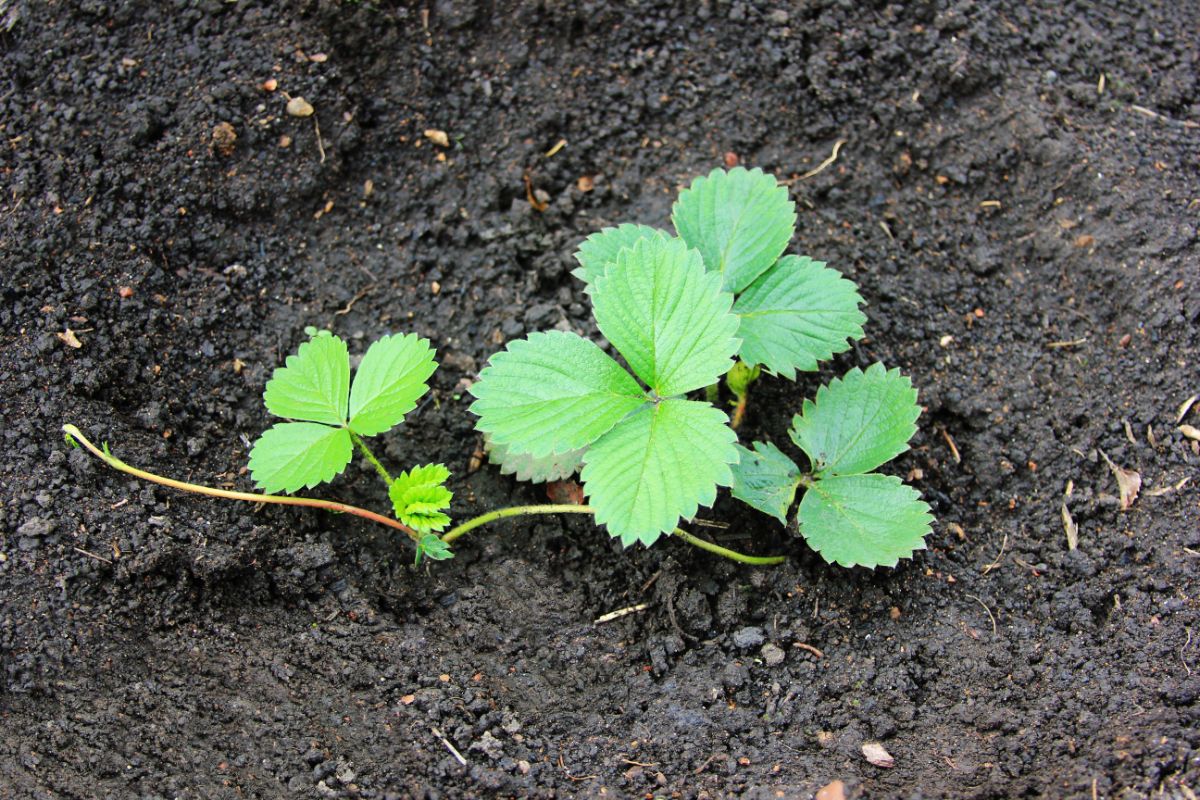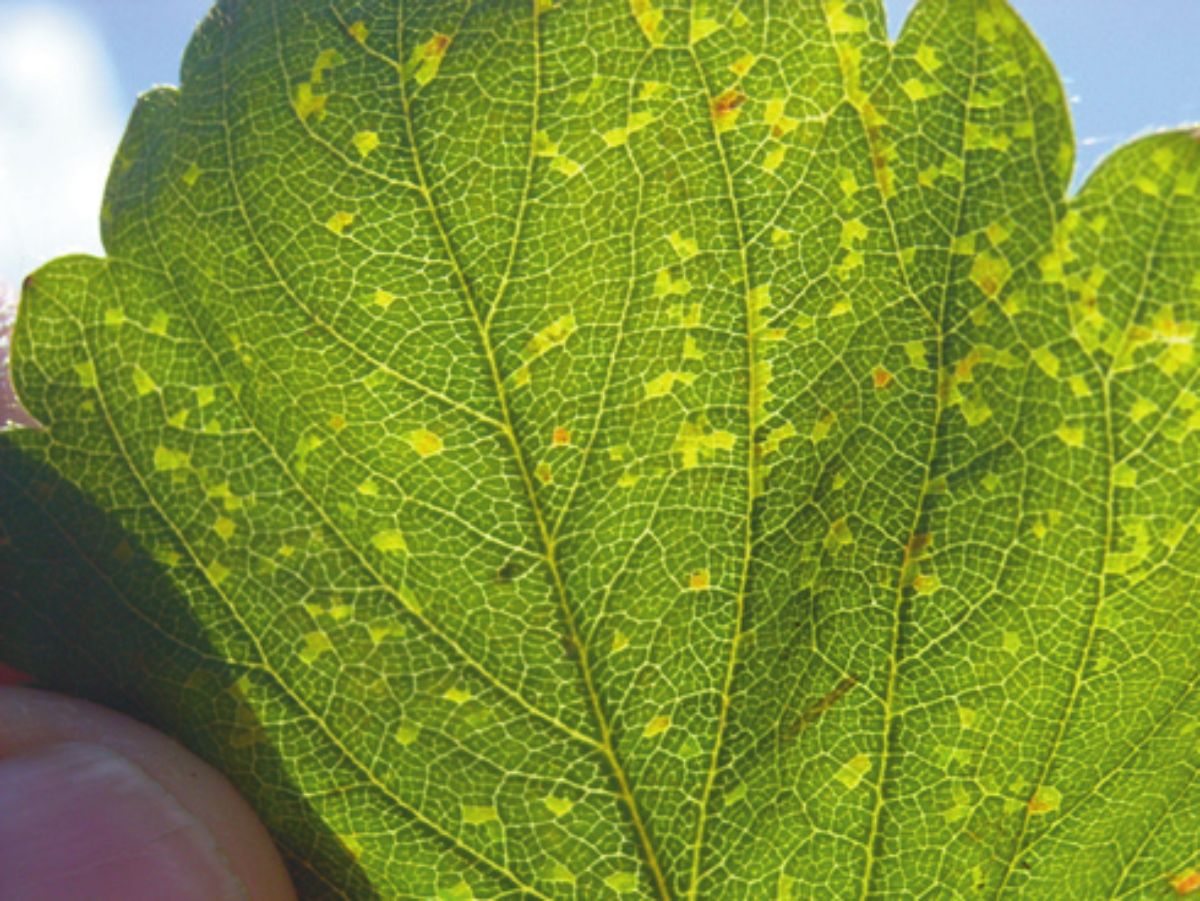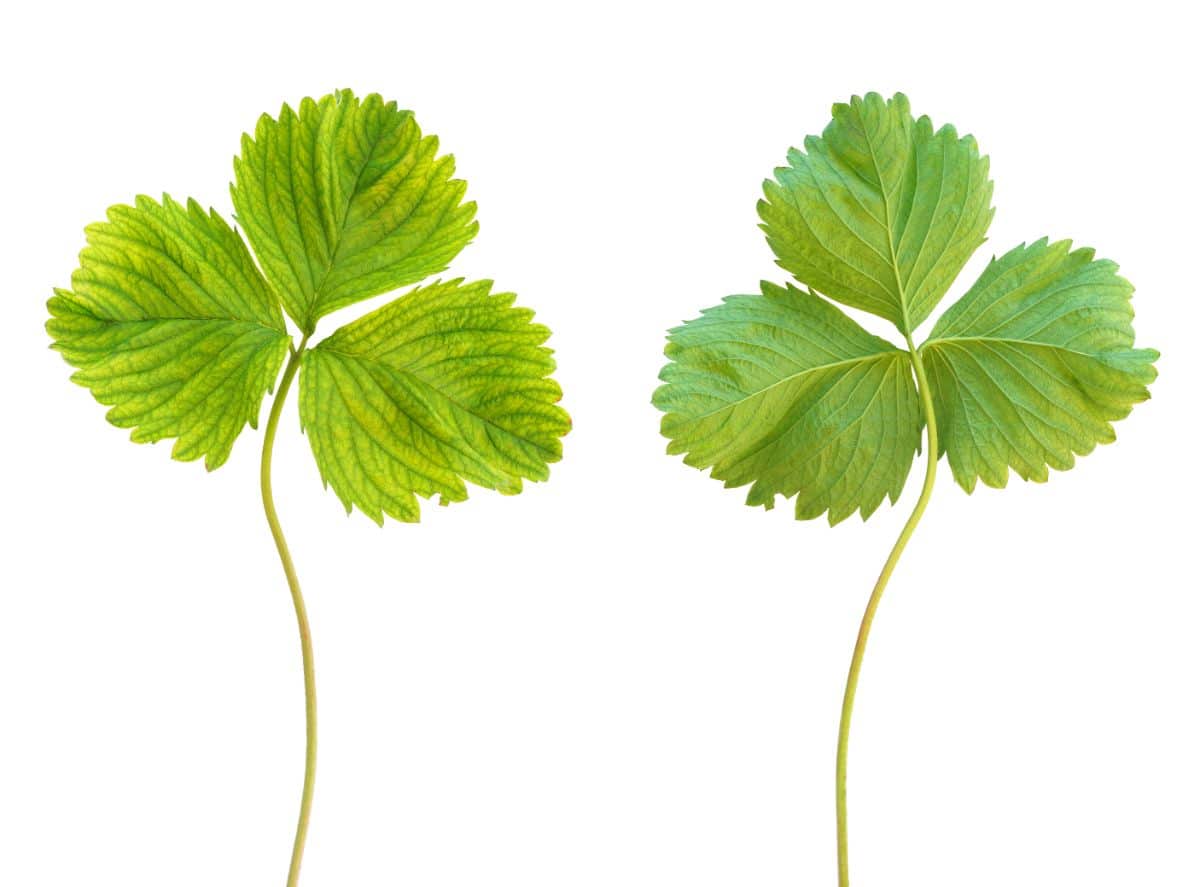How to Become a Strawberry Plant Whisperer or What Are My Strawberry Plant’s Leaves Telling Me?
Are your strawberry plants talking to you? Yes! Strawberry leaves can tell you a lot about the health of the plants and how many berries you are likely to get from them.
Often when we search the internet to learn what different colors on strawberry leaves mean, it seems we have to already know what the problem is. Here you can find the leaf signs and their meanings, not the other way around.[feast_advanced_jump_to]
Watery lesions on the back of strawberry leaves are a result of angular leaf spot caused by the bacteria Xanthomonas fragariae. The bacteria is hiding in your plant’s vascular system and oozing out of these lesions. It spreads in wet or humid conditions and enters wounds or natural openings on nearby plants.
If you notice an infected plant at this stage, separate it from healthy plants in dry conditions. You can try treating the plant with an antibiotic called validamycin. For home growers, the best solution is to remove the plant at the end of the season and let the bacteria left in the soil die over winter. Angular leaf spot alone doesn’t have too much impact on berry production.
White fluffy patches on leaves are powdery mildew. Powdery mildew attacks young leaves, flowers, and fruit. Spray your plants once a week with a mixture of 1 part milk to 2 parts water. The milk kills the fungus while nourishing the plant, and won’t harm beneficial bugs.
Powdery mildew will survive in the soil over winter so consider treating the whole bed with potassium bicarbonate to prevent future problems.
Is it the end of the season? Are temperatures dropping a little early? Red strawberry leaves could simply be showing you that the season is changing. They should come back in spring green and happy. If not, check into these other possibilities.
Strawberry leaves are an iconic and beautiful part of this delicious fruit bearing plant. But what exactly do strawberry leaves look like? Getting to know the appearance, shape, texture and color of healthy strawberry foliage can help you better care for your plants.
In this complete visual guide, we’ll explore the key features of strawberry leaves in detail. Whether you’re an experienced strawberry gardener or are just getting started with your first patch, understanding the nuances of strawberry plant leaves will ensure you have the knowledge to support vigorous growth and a bountiful harvest.
The Structure and Shape of Strawberry Leaves
Strawberry plants produce trifoliate leaves, meaning each leaf consists of three leaflets emerging from a central point on the petiole (leaf stem). The three leaflets are oval or heart-shaped with serrated, toothed edges.
The leaflets range in size from one to three inches long, with the central leaflet often being slightly larger than the two side leaflets. Each leaflet may have between 7-11 pointed teeth along its margin.
Overall, a strawberry leaf spans approximately 3–6 inches in width depending on the cultivar and plant maturity Leaves grow in an alternating pattern along the crown of the plant, with between 5-11 leaves present at each crown point
This trifoliate shape and serrated margin are key identifiers of strawberry leaves and make them easily distinguishable from other common garden plants.
The Color and Texture of Healthy Strawberry Foliage
Vibrant green leaves are a sign of healthy strawberry plants. The shade can range from light to medium green or have a slight blueish-green hue.
Young emerging leaves may have a reddish tint that transitions to green as they mature. Variegated cultivars can also exhibit splashes of white, yellow or pink on the leaves.
The texture of strawberry foliage is somewhat soft and flexible, with a slightly succulent feel. The upper surface of the leaves has a matte appearance while the underside is often shiny.
A healthy glossiness comes from a thin natural wax coating on the leaves that helps retain moisture. Too much or too little wax can indicate environmental stresses.
Changes Throughout Development
Strawberry leaves take on different shapes and characteristics as the plant progresses through its growth stages:
-
Seedlings – The first embryonic leaves (cotyledons) are small, smooth, spade-shaped and bright green. They lack the signature serrated edges.
-
Established plant – Mature strawberry plants have large trifoliate leaves with distinct serrated margins. Size and color intensity increases through the season.
-
Flowering – Once flowering begins, leaves tend to be medium green and intermediate in size. The serrated edges are very defined.
-
Fruiting – During peak harvest, leaves are dark green and large. The teeth along the edges may become less pronounced as resources focus on fruiting.
-
Overwintering – In cold climates, leaves turn red or orange in fall then wither. Plants in mild winter regions continue generating small green leaves.
Recognizing these patterns helps monitor plant health and development. Sudden leaf changes may reflect environmental issues, nutrient deficiencies, pests or diseases.
Variations Between Strawberry Leaf Types
While most strawberry leaves share the classic trifoliate shape, some cultivars exhibit their own distinct features:
-
Alpine – Glossy, small, deeply lobed leaflets with coarse serrations. Rich green color.
-
Everbearing – Delicate, soft green leaves with rounded, scalloped edges. Smaller leaflets.
-
June-bearing – Large, thick blue-green leaves with less prominent teeth. More wax coating.
-
Day-neutral – Medium green leaves similar to June-bearing but slightly more pointed shape.
There are also ornamental strawberries with variegated leaves. Getting to recognize your cultivar’s natural leaf attributes helps identify when changes occur.
Signs of Unhealthy Strawberry Leaves
Once you know what healthy strawberry foliage looks like, identifying problems becomes easier. Here are some common unhealthy leaf symptoms:
-
Yellowing or browning – Nutrient deficiencies, environmental stresses, pests or diseases.
-
Curled leaves – Sign of herbicide damage, mites, aphids, lygus bugs or moisture stress.
-
Wilting – Indicates inadequate watering, damaged roots, vascular disease or extreme heat.
-
Stunted growth – Usually signals poor nutrient levels, cold temperatures or compromised roots.
-
Spots or lesions – Caused by fungal diseases like leaf spot, powdery mildew, leaf blight or angular leaf spot.
-
Holes/missing sections – Leaf feeding pests like slugs, snails, caterpillars, beetles or grasshoppers.
Rapidly identifying issues through the leaves allows quicker treatment to restore plant health.
The Role of Strawberry Leaves
Beyond their visual appeal, strawberry leaves serve several vital functions:
-
Photosynthesis – Leaves absorb sunlight and carbon dioxide to generate energy through photosynthesis. This powers plant growth and fruit production.
-
Transpiration – The leaves release oxygen and water vapor while regulating water movement from the roots to the rest of the plant.
-
Protection – Leaves can shield developing berries from sun damage, heat stress and some pests.
-
Energy storage – Leaves store carbohydrates that will fuel spring growth and flowering. Evergreen types build reserves all winter.
Healthy leaves are essential for vigorous strawberry plants and maximizing yields. Monitoring leaves provides insight into overall plant health and performance.
Tips for Care Based on Leaf Cues
Noticing leaf cues allows you to provide tailored care for robust strawberries:
-
Yellow leaves may indicate the need for more nitrogen fertilizer.
-
Dry, shriveled leaves call for more frequent watering.
-
Leaf spot diseases warrant treatment with neem oil or sulfur sprays.
-
Slug or snail damage shows the need for traps, barriers or iron phosphate bait.
-
Cold weather leaf damage means more winter mulch is needed.
The appearance and condition of your strawberry leaves provides a wealth of information to guide appropriate care.
Take a Closer Look
Now that you know what to look for, it’s helpful to see strawberry leaves up close. Here are some key traits to observe:
[Photo 1: Vibrant green, medium sized trifoliate leaf, mature serrations visible]
The classic trifoliate shape and serrated margin of a healthy strawberry leaf.
[Photo 2: Newly emerged strawberry seedling with smooth, spade-shaped cotyledons]
Early seedling stage leaves lack serrations and have a rounded form.
[Photo 3: Severe leaf spot disease infection, dark spots across surface]
Notice the black lesions from fungal leaf spot disease on these unhealthy leaves.
[Photo 4: Curled, deformed strawberry leaf with signs of mite damage]
Curled, twisted leaves may reflect pest infestations, herbicide damage or environmental stresses.
Noticing subtle details on your strawberry foliage will help you become a more observant and informed grower.
Strawberry Leaf Patterns and Illustrations
Seeing strawberry leaves in context provides a clearer picture of their natural growth patterns:
[Illustration 1: Line drawing of whole strawberry plant with labeled parts like trifoliate leaves, flowers, petioles, runners, crown.]
This illustration labels a strawberry plant’s key structures, including the distinctive leaves.
[Illustration 2: Strawberry foliage samples demonstrating shape and color variations]
Examples of different strawberry leaf shapes and colors across popular cultivars.
[Illustration 3: Progressing growth stages – new leaves, flowering, fruiting, overwintering]
Strawberry plant development shown through changes in leaf size, color and plant form.
Observing the leaves as part of the entire plant throughout its lifecycle gives a more complete understanding.
Summing Up Strawberry Leaf Appearance
Getting familiar with the look and features of strawberry leaves prepares you to better nurture your plants. Seeking out vivid green, classic trifoliate leaves with good color and vigor is the first step to robust strawberry patches.
Noticing early signs of leaf damage or stress provides opportunities for quick action to restore plant health. Learning to read strawberry leaves takes your gardening skills to the next level.
With this visual guide as reference, you’ll be able to assess and appreciate the beauty of healthy strawberry foliage. Taking time to observe those lovely leaves as they unfurl and grow will make you a smarter, more attentive strawberry farmer.

Translucent lesions that appear yellow when held up to the light
This speckling is caused by angular leaf spot caused by the bacteria Xanthomonas fragariae. The bacteria hiding in your plant’s vascular system oozed out of lesions on the back of the leaves and may have now dried into a white powder. It spreads in wet or humid conditions and enters wounds or natural openings on nearby plants.
If you notice an infected plant at this stage, separate it from healthy plants in dry conditions. You can try treating the plant with an antibiotic called validamycin. For home growers, the best solution is to remove the plant at the end of the season and let the bacteria left in the soil die over winter. Angular leaf spot alone doesn’t have too much impact on berry production.

Photo by Michael A. Ellis as found on Ohioline.edu
Green veins on yellow background
If the leaves turn a uniform yellow-green but the leaves remain dark green, often the problem is an iron deficiency. This is more common in hydroponic gardens. Try a foliar fertilizer.

5 Winter Strawberry Do Nots – Garden Quickie Episode 28
FAQ
What can be mistaken for strawberries?
Potentilla indica, known commonly as mock strawberry, Indian strawberry, or snakeberry in North America, is a flowering plant in the family Rosaceae. It has ternate foliage and an aggregate accessory fruit, similar to true strawberries of the genus Fragaria.
What is the shape of a wild strawberry leaf?
The leaves are green on top and pale green underneath. Each leaflet is about 3 inches long and 1.5 inches wide. The leaflets are oval shaped and have coarse teeth along the edge except near the bottom. Flower | Seeds: The wild strawberry flowers in April, May and June.
